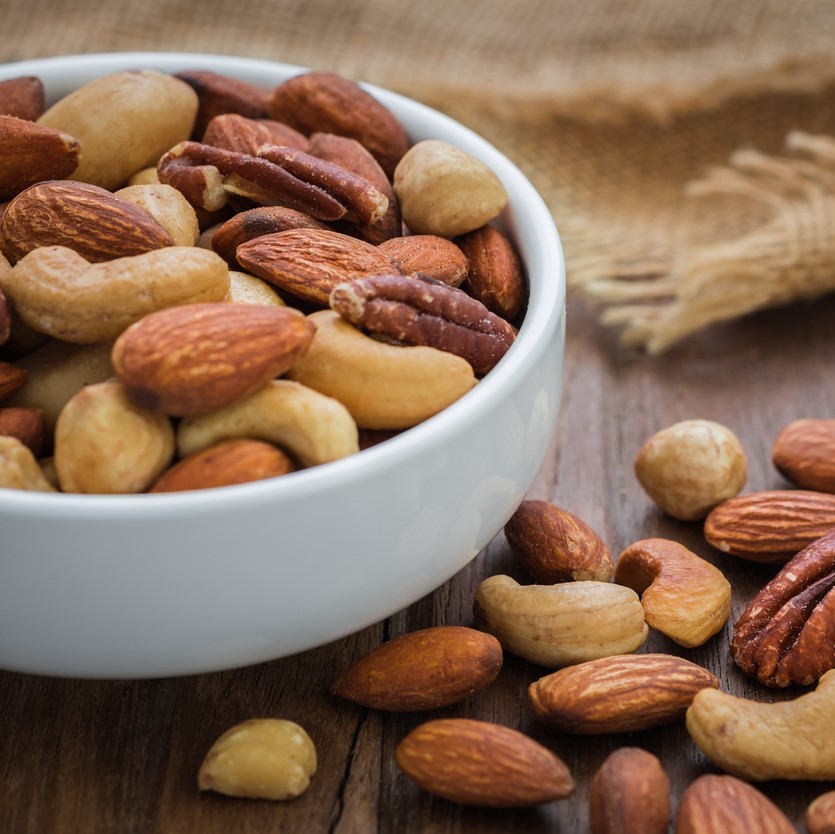- Tree nuts are considered priority allergens by Health Canada.
- Priority food allergens are the foods that cause the majority of allergic reactions.
- Tree nuts include almonds, Brazil nuts, cashews, hazelnuts, macadamia nuts, pecans, pine nuts (pignolias), pistachio nuts and walnuts.
- Peanuts are part of the legume family and are not considered a tree nut.
- Some people with a tree nut allergy may be allergic to more than one type of tree nut. While others may only be allergic to one type of tree nut.
- If there is no risk of cross-contamination and a type of tree nut is tolerated, there is no reason to exclude that tolerated tree nut – the person can keep it in their diet. If they are unsure which tree nuts they can tolerate, they can speak to their allergist.
- Coconut and nutmeg are not considered tree nuts for the purposes of food allergen labelling in Canada and are not usually restricted from the diet of someone allergic to tree nuts.
- A coconut is a seed of a fruit and nutmeg is obtained from the seeds of a tropical tree.
- However, some people allergic to tree nuts have also reacted to coconut and nutmeg. Consult your allergist before trying coconut- or nutmeg-containing products.
Allergic reactions to tree nuts
An allergic reaction usually happens within minutes after being exposed to an allergen, but sometimes it can take place several hours after exposure. Anaphylaxis is the most serious type of allergic reaction.
Symptoms of anaphylaxis generally include two or more of the following body systems:
- Skin: hives, swelling (face, lips, tongue), itching, warmth, redness
- Respiratory (breathing): coughing, wheezing, shortness of breath, chest pain/tightness, throat tightness, hoarse voice, nasal congestion or hay fever-like symptoms (runny itchy nose and watery eyes, sneezing), trouble swallowing
- Gastrointestinal (stomach): nausea, pain/cramps, vomiting, diarrhea
- Cardiovascular (heart): paler than normal skin colour/blue colour, weak pulse, passing out, dizziness or lightheadedness, shock
- Other: anxiety, sense of doom (the feeling that something bad is about to happen), headache, uterine cramps, metallic taste
If you have an allergy to tree nuts, keep an epinephrine auto-injector (e.g., EpiPen®, ALLERJECT®) with you at all times. Epinephrine is the first-line treatment for severe allergic reactions (anaphylaxis).
Be Allergy-Aware: How to avoid tree nuts
- Read ingredient labels every time you buy or eat a product. If the label indicates that a product “Contains” or “may contain” tree nut, do not eat it. If you do not recognize an ingredient, if there is no ingredient list available, or if you don’t understand the language written on the packaging, avoid the product.
- According to Health Canada:
- If a tree nut is part of the ingredients, the specific tree nut(s) must be declared by their common name (almond, Brazil nut, etc.) in the list of ingredients or in a separate “contains” statement immediately following the list of ingredients.
- Do The Triple Check and read the label:
- Once at the store before buying it.
- Once when you get home and put it away.
- Again before you serve or eat the product.
- Always carry your epinephrine auto-injector. It’s recommend that if you do not have your auto-injector with you, that you do not eat.
- Check with manufacturers directly if you are not sure if a product is safe for you.
- Be careful when buying imported products, since labelling rules differ from country to country.
- Watch for cross-contamination, which is when a small amount of a food allergen (e.g., almond) gets into another food accidentally, or when it’s present in saliva, on a surface, or on an object. This small amount of an allergen could cause an allergic reaction.
Common tree nuts
- Almonds
- Brazil nuts
- Cashews
- Hazelnuts (filberts)
- Macadamia nuts
- Pecans
- Pine nuts (pinon, pignolias)
- Pistachios
- Walnuts
Other names for tree nuts
- Anacardium nuts
- Mandelonas (a nut-flavoured peanut confection)
- Nut meats
- Queensland nut (macadamia)
Possible sources of tree nuts
- Alcoholic beverages, such as Frangelico, amaretto liqueurs and others
- Baked goods such as biscotti, cakes, cookies, crackers, donuts, granola bars, pastries and pies, baklava, baking mixes
- Barbecue sauce
- Candies, such as calisson, mandelonas, marzipan, some chocolates, chocolate bars
- Cereals, granola, muesli
- Health and Nutritional supplements, such as herbal remedies and vitamins
- Herbal teas
- Hot cocoa and cocoa mixes
- Ice cream, gelato, frozen desserts, sundae toppings, frozen yogurt, pralines
- Main course dishes such as butter chicken, chicken korma, mole sauce, pad thai, satay, chili, other gravy dishes
- Natural flavourings and extracts
- Nut-flavoured coffees, hot cocoa, specialty drinks
- Peanut oil
- Pesto sauce
- Salads and salad dressings
- Smoke flavourings
- Snack food like chips, popcorn, snack mixes, trail mix
- Spreads and Nut butters (e.g., Nutella and gianduia/gianduja)
- Vegetarian dishes
Non-food sources of tree nuts
- Beanbags, kick sacks/hacky sacks
- Bird seed
- Cosmetics, skin and hair care products, lotions, soap, body scrubs, sun screens
- Massage oils
- Pet food
- Sandblasting materials
Note: The above lists are not complete and may change.
Report a reaction
If you believe you may have reacted to an allergen not listed on the packaging, you can report it to the Canadian Food Inspection Agency, which may issue a product recall. Find out more on our Food Labelling page.

